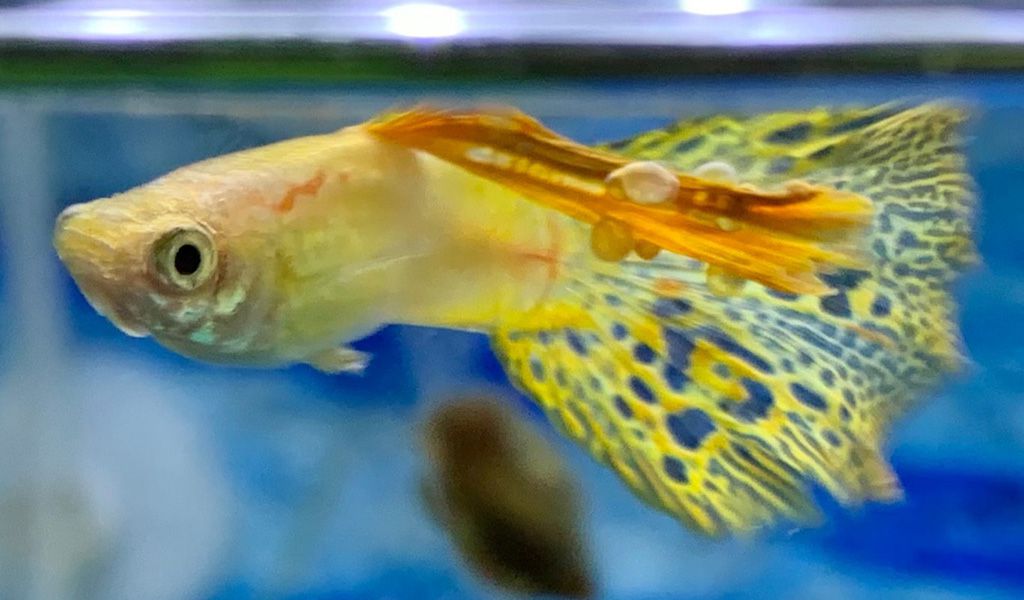To treat gas bubble disease in freshwater fish, relocate the fish into deep water with higher pressures to dissolve excess gases in their body tissues and eventually eliminate gas bubbles. Gentle stirring of the water and slight lowering of the temperature can also help degas the water and prevent gas bubble formation.
A poor water quality that leads to bloat can be resolved by correcting water parameters and performing regular water changes. Overfeeding can also cause bloat, so feeding smaller meals and switching to a more appropriate diet can help alleviate the condition.
Gas bubble disease is non-infectious and environmentally/physically induced, caused by an increase in dissolved gas pressure above ambient air pressure. Treating the source of excess gases and removing them may require lancing select bubbles and using antibiotics to prevent infection.

Credit: veterinaryvisioncenter.com
Understanding Gas Bubble Disease
Gas Bubble Disease is a health condition that affects freshwater fish. It occurs when gases, usually nitrogen, in the water become dissolved in the fish’s bloodstream and tissues. As the fish ascends to the surface or experiences sudden changes in water pressure, these gases can form bubbles within the fish’s body, leading to various symptoms and potential harm. Understanding this disease is crucial for effective treatment and prevention.
Gas Bubble Disease is primarily caused by supersaturation of gases in the water. When the concentration of gases, such as nitrogen, exceeds the threshold that can dissolve in the water at a given pressure, it can lead to gas bubble formation. Factors that contribute to supersaturation include:
- High levels of gas in the water due to aeration or excessive bubbling
- Low atmospheric pressure, such as during storms or high altitudes
- Fast water flow or turbulent conditions that promote gas infiltration
- Dramatic changes in water temperature, particularly sudden increases
Recognizing the symptoms of Gas Bubble Disease is essential for early detection and intervention. Some common signs that a fish may be experiencing this condition include:
- Visible gas bubbles on the skin, fins, or inside the fish’s mouth
- Abnormal swimming behaviors, such as erratic movements or staying at the water surface
- Loss of balance or buoyancy control
- Difficulty breathing, indicated by rapid gill movement or gasping at the water surface
- Distended abdomen or bloating
- Red or swollen eyes
If you notice any of these symptoms in your freshwater fish, it is crucial to act quickly to prevent further harm and improve their chances of recovery. Understanding the causes and symptoms of Gas Bubble Disease is the first step towards effective treatment.

Credit: veterinaryvisioncenter.com
Treating Gas Bubble Disease
Gas bubble disease in freshwater fish can be treated by relocating them into deeper water with higher pressures to dissolve the excess gases. Gentle stirring of the water and slight temperature lowering can also help degas the water and alleviate the condition.
Relocating Fish To Deep Water
Relocating fish to deep water is an effective method for treating gas bubble disease in freshwater fish. By placing the affected fish in water that has higher pressures, more gases can be dissolved into the water, helping to remove the gas bubbles. When fish are in deep water, nitrogen excess in their body tissues is dissolved, and over time, the gas bubbles will disappear. This natural process of dissolving gases in deep water allows the fish to recover from gas bubble disease.Stirring And Cooling The Water
Gentle stirring of the water can help degas it, aiding in the treatment of gas bubble disease. By creating a gentle disturbance in the water, excess gases can be released, relieving the fish from gas bubbles. Additionally, lowering the temperature of the water slightly can be beneficial. Cooler water naturally holds more dissolved gas, which can help alleviate the symptoms of gas bubble disease. It is important to cool the water gradually, only a few degrees at a time, to prevent any sudden changes that could further stress the fish.Identifying And Removing Excess Gases
To effectively treat gas bubble disease in freshwater fish, it is crucial to identify and remove the source of excess gases. Bubbles trapped inside the fish may or may not resolve when gas saturation normalizes, so it is necessary to take appropriate measures. Some veterinarians choose to lance select bubbles, although this procedure should only be performed by professionals. Following this procedure, antibiotics may be required to prevent infection. By addressing the root cause of the excess gases, fish can recover from gas bubble disease and prevent its recurrence.Preventing Gas Bubble Disease
Gas bubble disease can be a serious condition that affects freshwater fish, but there are steps you can take to prevent it from occurring. By controlling oxygen levels in the water, maintaining proper water quality and feedings, and aerating the water, you can help reduce the risk of gas bubble disease in your fish.
Controlling Oxygen Levels In The Water
One of the key factors in preventing gas bubble disease is maintaining appropriate oxygen levels in the water. Fish require oxygen to breathe, and if the level of dissolved oxygen in the water becomes too low, it can lead to stress and decreased immunity, making fish more susceptible to gas bubble disease.
To ensure proper oxygen levels in the water, consider the following:
- Provide adequate surface agitation: Increasing surface agitation, such as using a water filter or placing an airstone in the tank, can help oxygenate the water.
- Avoid overcrowding: Overcrowding can lead to oxygen depletion in the water. Make sure you provide enough space for your fish to swim freely and have access to oxygen.
- Monitor water temperature: Warmer water holds less dissolved oxygen than cooler water. Ensure the water temperature is within the optimal range for your fish species.
Proper Water Quality And Feedings
Another important aspect of preventing gas bubble disease is maintaining proper water quality and feedings. Poor water quality and overfeeding can contribute to the development of gas bubbles in fish.
Consider the following tips:
- Regular water testing: Test your water regularly to ensure optimal water parameters, including ammonia, nitrite, nitrate, and pH levels. High levels of pollutants can stress fish and lead to gas bubble disease.
- Perform regular water changes: Regular water changes help remove excess waste and maintain water quality. Aim for weekly water changes of around 25% to keep the aquarium environment clean for your fish.
- Feed appropriate amounts: Overfeeding can lead to digestive issues and gas bubble disease. Feed your fish small, frequent meals that they can consume within a few minutes. Follow the feeding guidelines specific to your fish species.
Aerating The Water
In addition to controlling oxygen levels and maintaining proper water quality, aerating the water can help prevent gas bubble disease. By increasing surface agitation and promoting gas exchange, you can ensure a well-oxygenated environment for your fish.
To aerate the water:
- Use an airstone or air pump: Placing an airstone or utilizing an air pump can introduce bubbles and increase water movement, facilitating gas exchange.
- Adjust water flow: If you have a water filter, adjust the flow rate to create more surface agitation. This will help increase oxygen levels in the water.
By implementing these preventive measures, you can reduce the risk of gas bubble disease in your freshwater fish. Remember to regularly monitor water conditions and provide appropriate care to maintain a healthy and thriving aquarium environment for your fish.

Credit: www.hygger-online.com
Frequently Asked Questions Of How To Treat Gas Bubble Disease In Freshwater Fish
Can Fish Recover From Gas Bubble Disease?
Fish can recover from gas bubble disease by being relocated to deep water with higher pressures. This allows excess nitrogen to be dissolved into the body tissues and the gas bubbles will eventually disappear. Gentle stirring and lowering the water temperature can also help degas the water.
How Do I Get Rid Of Gas Bubbles In My Fish Tank?
To get rid of gas bubbles in your fish tank, gently stir the water to degas it. Lowering the water temperature slightly can also help, as cooler water holds more dissolved gas naturally. Additionally, make sure to maintain proper water quality and avoid overfeeding.
Regular water changes and a balanced diet can help prevent gas bubble disease.
How Do You Get Rid Of Gas In Fish?
Gently stir the water to release trapped gas bubbles. Lower the water temperature slightly to increase dissolved gas. Improve water quality and perform regular water changes. Avoid overfeeding and switch to a suitable diet. Relocate fish to deeper water with higher pressure to dissolve excess gases.
Is Gas Bubble Disease Contagious To Other Fish?
Gas bubble disease is not contagious to other fish. It is a non-infectious, environmentally induced trauma caused by an increase in dissolved gas pressure.
Conclusion
To effectively treat gas bubble disease in freshwater fish, it is important to understand the causes and take appropriate measures. Relocating fish into deep water with higher pressures can help dissolve excess gases in their body tissues, eventually eliminating the gas bubbles.
Gentle stirring of the water and slightly lowering the temperature are also effective methods. Identifying and removing the source of excess gases is crucial, and in some cases, veterinarians may choose to lance select bubbles. By following these steps, you can prevent and treat gas bubble disease in your freshwater fish, ensuring their health and well-being.

